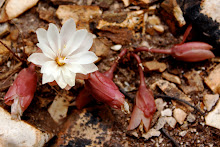I have a very strong belief that one day this society will start failing (more than it already has) - that there will be food shortages and people who do not know someone that farms or know how to farm themselves will starve to death. This dependence on just about everything but ourselves is terrifying to me, and I'd like to be as self-sustaining as possible, pretty much as soon as possible.
Thus begins my adventure in suburban gardening in Bend, Oregon. For those of you not local, I will explain why this area is a particularly large challenge. Bend is situated on the east side of the Cascade Mountains, in what's known as a rain shadow. This means that the other side of the mountains get all the rain - when the air comes up over the mountains, it drops the moisture on the west side and by the time it gets to us, it's dry as hell. What this means is less than twelve inches of rain annually. During the summer, it is possible to go an entire month with no rain. Added to that, our high elevation means that AT ANY TIME, during ANY SEASON, we can experience a plant-killing frost at night. The last 'frost-free date' (the time when you can plant things outside without worrying about them dying) is in June - at least a month or two later than other temperate areas. I was told by the Extension service that Bend essentially does not have a frost-free date because we're likely to get a frost in July or August at some point.
So what we have is no water and the potential for summer frost. At first I was pretty bummed about the odds here, but if I can successfully manage a harvest here, than I'll be fine wherever I end up next. (Kind of like learning how to mountain bike at Susquehanna - now I'm set.)
Erin and I will be developing our arsenal over the next few months: first, a seedling table that we created for free by dumpster diving and utilizing scrap wood. We'll start our seeds months ahead of time in some cases and transplant them outside in June. Next, we'll be constructing a coldframe from some windows we found at a dumpster. A coldframe is a box with a heat-conducting surface (like glass) that keeps the inside of said box many degrees warmer than the outside air temperatures. A coldframe can be used to transplant your plants early, or placed over them in the event of a frost to keep them from freezing. We'll also use row-covers, cloches, and whatever other means necessary to keep our plants safe to the best of our ability. Next, we are building raised beds for the vegetables. This will help the soil to stay warmer and give the plants more room to grow. It will also allow us to construct our own soil mix, rather than relying on what's currently on the ground. Finally, we have collected from thrift stores four huge containers (for an impressive collective price of $9) which will each hold multiple vegetable plants and can be brought inside in the event of a frost.
I also spent a few hours collecting close to 40 gallons of rainwater the last time it rained. This amounts to like one week of watering, but it's one week that we'll not have to use a garden hose. I have to find a cistern or big garbage can to hold it all so I can continue to collect snowmelt as well.
That's the basic plan. We are planning to grow:
> 3-4 types of tomatoes, all of which are considered more "cold-hardy" species and two of which hail from cold-ass Eastern Europe or Russia
> a cold-hardy strain of broccoli
> swiss chard, a hearty green
> spinach and lettuce
> red-meat radishes, which are red on the inside and white on the outside
> 2-3 types of potatoes
> 3 types of onions
> an heirloom parsnip (which I'm looking forward to, as exposure to frost actually improves the flavor... take THAT Central Oregon)
> 2 types of "stress-tolerant" corn - we've been told corn is an impossibility in Bend, which has made us that much more determined to grow it, and if we get one bloody ear, we will be satisfied
> carrots
> 2 types of beans, potentially, one of which is 'cold-hardier' than others
> sweet peppers, one of my personal favorites
> winter and summer squash
On top of these, we'll grow insect-repelling flowers like nasturtiums and coreopsis to aid in the fight against pests. I also plan to have some flower gardens, but that's a later post.
As you can see, the biggest things to consider in your climate are: soil temperature (in Bend, nights are cold so plants will not grow at night like they will in, say, Maryland), frost possibilities, length of season (we're about a whopping 80 days or so), water, and disease-resistance of your plants. Of course you also have to consider carefully your soil composition, location of gardens for available sunlight, and be prepared to fight pests.
I'll be back in a few - I am cooking up a batch of my grandmother's Sicilian pasta sauce. I make a ton at once and freeze most of it for easy future meals.

No comments:
Post a Comment